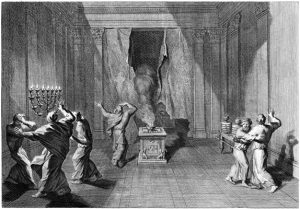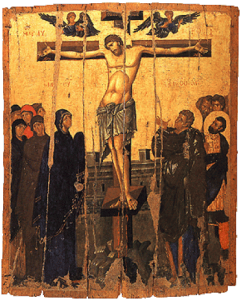On Holy Thursday, in preparation for the Blessing of the Water at the Easter Vigil, holy water is removed and the main Tabernacles in churches around the world are emptied.
Holy Mass is not celebrated on Good Friday or Holy Saturday. The Tabernacles are entirely empty and the doors left wide open, and the Sanctuary Lamps are extinguished, to show the Sacramental absence of Jesus in the Church. The Altar is stripped and Crosses are removed from the church or veiled if they remain.
These visible signs point out the reality of the starkness of Jesus’ sacrifice and what we would truly be missing in our lives if Jesus had not died on the Cross and risen from the dead; we would have nothing, no hope of eternal life. Perhaps it can also remind us not to take what we have – the Holy Mass, the Priesthood, the Sacramentals and all God’s gifts to his Church – for granted.
Two veils hung in the Jerusalem temple, where the Jewish people made their sacrifices to God the Father, in sorrow and in reparation for their sins. The veils symbolised God’s inaccessibility to sinners (Heb 9:8). One was visible, as it separated the outer courts of the temple from the sanctuary proper; the other could not be seen by anyone except the Jewish priests, as it hung  inside the sanctuary in front of the most Sacred chamber, the Holy of Holies (Ex 26:31-34; Heb 9:3,7).
inside the sanctuary in front of the most Sacred chamber, the Holy of Holies (Ex 26:31-34; Heb 9:3,7).
Although the Evangelist does not specify which of the two veils were torn from top to bottom after the death of Jesus, the lesson to be learned is clear: access to the Father is now open through Jesus who, as true High Priest, has entered on our behalf ( Eph 2:18; Heb 10:19-22). Moreover, as the veil ripped from top to bottom, the barrier between the face of God and His people is removed and the termination of the Old Covenant was prophetically announced.
 St Mark tells us the veil was ‘torn’. He uses the same Greek word in 1:10 to describe God the Father tearing the heavens at the Baptism of Jesus. If a connection is being made between the two events, it may have been the outer veil draped in front of the sanctuary that was rent in two; the historian Josephus testifies that it was embroidered with images of the cosmos.
St Mark tells us the veil was ‘torn’. He uses the same Greek word in 1:10 to describe God the Father tearing the heavens at the Baptism of Jesus. If a connection is being made between the two events, it may have been the outer veil draped in front of the sanctuary that was rent in two; the historian Josephus testifies that it was embroidered with images of the cosmos.
We now see all the images in the church veiled, as well as the Cross above the sanctuary. The symbolism is that we live in a veiled world, in exile from our true home, Heaven. It is only through Jesus’ death and Resurrection, when he reveals Himself as victorious and risen, that Christ lifts the veil and that, through our own deaths, we are united with Jesus, sharing in eternal life.
We unveil the Cross after the Solemn celebration of the Passion on Good Friday; we unveil images at the beginning of the Easter Vigil.
Comments are closed, but trackbacks and pingbacks are open.